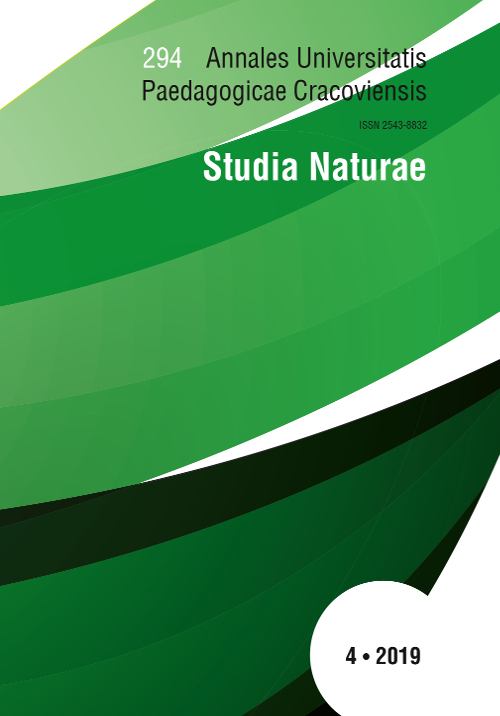The bio-flavanoid concentrate of Vitis vinifera L. ‘Red Aladasturi’
DOI:
https://doi.org/10.24917/25438832.4.5Keywords:
anthocyanins, antioxidant activity, grapes, phenolic compounds, Vitis vinifera ‘Red Aladasturi’Abstract
This paper dwells on the uvological characteristics of cultivar Vitis vinifera L. ‘Red Aladasturi’ grape raw materials growing in the viticulture and winemaking zone of Imereti (Georgia), as well as biologically active compounds and antioxidant activity of hydrophilic extracts and liquid concentrates of its solid matters (stone and skin). Research also covered hydrophilic extracts of grape skin and stone thickened by the vacuum of ‘Red Aladasturi’ grapes raw materials, as well as the concentrates produced from their composition. For research, there were used gravimetric, extractive, spectral and chromatographic methods. We processed samples of grapes raw materials according to the following pattern: identifying qualitative indicators of grapes raw materials; passing grapes raw materials through the DMCSI-type grape clustercomb divider; pressing-out the combless must in a basket press and separation of juice; vacuum sublimation drying of juiceless sweet pomace with an initial moisture content of 45-65% to a final moisture content of 9-10%; separation of the ‘Red Aladasturi’ cultivar’s skin and stone dried to the moisture content of 9-10%, using tea sorting machine designed by G. Lominadze; crushing separately the skin and stone in a micro-mill (TP2 Hammer Mill) until the fraction of 50-100 µm. we have blended the obtained grape-stone ethanol and fluid extracts containing 74-75% of solid maters at an equal ratio (1:1:1) and assessed biologically active compounds and antioxidant activity in this composition. It has been established that the bio-flavanoid liquid concentrate ‘Red Aladasturi’ is strong antioxidant (55.31-57.45%), and one tablespoon or 8-9 ml of it contains 110-127 mg of flavanoids, which is 105-110% of a full day of rations per person per day.
Downloads
Metrics
References
Benmeziane, F., Cadot, Y., Djamai, R., Djermoun, L. (2016). Determination of major anthocyanin pigments and flavonols in red grape skin of some table grape varieties (Vitis vinifera sp.) by high-performance liquid chromatography–photodiode array detection. OENO One Journal of Vine and Wine, 50(3), 125–135. https://doi.org/10.20870/oeno-one.2016.50.3.56
Demrow, H.S., Slane, P.R., Folts, J.D. (1995). Administration of wine and grape juice inhibits in vivo platelet activity and thrombosis in stenosed canine coronary arteries. Circulation, 91, 1182–1188. https://doi.org/10.1161/01.CIR.91.4.1182
El Darra, N., Tannous J., Mouncef, P.B., Palge, J., Yaghi, J., Vorobiev, E., Louka, N., Maroun, R.G. (2012). A comparative study on antiradical and antimicrobial properties of red grapes extracts obtained from different Vitis vinifera varieties. Food and Nutrition Sciences, 3(10), 1420–1432. https://doi.org/10.4236/fns.2012.310186
Giusti, M.M., Ronald, E. (2001). Wrolstad characterization and measurement of anthocyanins by UV-Visible spectroscopy. Contributed by Current Protocols in Food Analytical Chemistry. New York: John Wiley & Sons, Inc. https://doi.org/10.1002/0471142913.faf0102s00
Gómez-Alonso, S., García-Romero, E., Hermosín-Gutiérrez, I. (2007). HPLC analysis of diverse grape and wine phenolics using direct injection and multidetection by DAD and fluorescence. Journal of Food Composition and Analysis, 20(7), 618–626. https://doi.org/10.1016/j.jfca.2007.03.002
Gvinianidze, T., Gvinianidze, T. (2018). Some aspects of red special wines. Journal of Environmental and Soil Sciences, 1(4), 83–87. https://doi.org/10.32474/ OAJESS.2018.01.000116
Gvinianidze, T., Gvinianidze, T., Chikovani, P., Mindeli, V., Metreveli, A. (2018). Research of anthocyanins in red special wine “Nikala”. Bulletin of Science and Practice, 4(12), 262–267. [In Russian]
Gvinianidze, T., Kamkamidze, N., Tsutskiridze, N. (2019). Some aspects of recycling and storage of secondary resources of grape. Bulletin of Science and Practice, 5(7), 128–134.
Gvinianidze, T.N., Chikovani, P.M, Gvinianidze, T.T., Jabnidze, R.H., Mindeli, V.A. (2017). Colored grape polyphenol concentrate. Annals of Agrarian Science, 15(4), 472–475. https://doi.org/10.1016/j.aasci.2017.08.004
Gvinianidze, T.N., Karchava, M.S., Jabnidze, R.H. (2018). Polyphenolic extracts of red grapes. Agricultural Research & Technology Open Access Journal, 16(2), 1–6. https://doi.org/19080/ARTOAJ.2018.16.555981
Kammerer, D., Claus, A., Carle, R., Schieber, A. (2004). Polyphenol screening of pomace from red and white gravarieties (Vitis vinifera L.) by HPLC-DAD-MS/MS. Journal Agriculture of Food Chemistry, 52(14), 4360–4367. https://doi.org/10.1021/jf049613b
Ketskhoveli, N., Ramishvili, M., Tabidze, D. (1960). Ampelography of Georgia. Tbilisi: Academy of Scientes. [In Georgian]
Kurkin, V.A., Kurkina, A.V., Avdeeva, E.V. (2013). Flavonoids as biologically active compounds of medicinal plants. Science Journal Basic Research, 11(9). [In Russian]
Kvesitadze, E., Kharadze, M., Vanidze, M., Kalandia, A. (2019). Dependence of phenolic compound content on geographical distribution of chkhaveri grapes in Adjara. Bulletin of the Georgian National Academy of Sciences, 13(1), 101–108.
Mensor, L.L., Menezes, F.S., Leitão, G.G., Reis, A.S., dos Santos, T.C., Coube, C.S., Leitão, S.G. (2001). Screening of Brazilian plant extracts for antioxidant activity by the use of DPPH free radical method. Phytotherapy Research, 15(2), 127–130. https://doi.org/10.1002/ptr.687
MorandiVuolo, M., SilvaLima V., Maróstica, M.R. (2019). Phenolic compounds: structure, classification, and antioxidant power. Bioactive Compounds, Health Benefits and Potential Applications, 33–50. https://doi.org/10.1016/B978-0-12-814774-0.00002-5
Palomino, O., Gómez-Serranillos, M.P., Slowing, K., Carretero, E., Villar, A. (2000). Study of polyphenols in grape berries by reversed-phase high-performance liquid chromatography. Journal of Chromatography A, 870(1–2), 449–451. https://doi.org/10.1016/S0021-9673(99)01225-X
Prior, R., Wu, X., Schaich, K. (2005). Standardized methods for the determination of antioxidant capacity and phenolics in foods and dietary supplements. Journal Agriculture of Food Chemistry, 53(10), 4290–4302. https://doi.org/ 10.1021/jf0502698
Rajha, H.N., El Darra, N., Vorobiev, E., Louka, N., Maroun, R.G. (2013). An environment friendly, low-cost extraction process of phenolic compounds from grape byproducts. Optimization by multi-response surface methodology. Food and Nutrition Sciences, 4, 650–659. https://doi.org/10.4236/fns.2013.46084
Singleton, V.L., Orthofer, R., Lamuela-Raventós, R.M. (1999). Analysis of total phenols and other oxidation substrates and antioxidants by means of folin–ciocalteu reagent. Methods in Enzymology, 299, 152–178. https://doi.org/10.1016/S0076-6879(99)99017-1
Yilmaz, Y., Тоledo, RT. (2004). Major flavonoids in grape seeds and skins: antioxidant capacity of catechin, epicatechin, and gallic acid. Journal Agriculture of Food Chemistry, 52(2), 255–260. https://doi.org/10.1021/jf030117h
Zharskaya, O.M., Gorgun, Yu, V., Karaseva, G.A., Ulasevich, D.N., G.M. (2014). Usov. Grape seed extract: from ancient empiric medicine till up-to-date confirmation. Meditsinskie Novosti, 4, 16–20. [In Russian]

